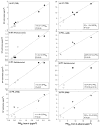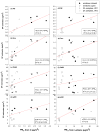Quantification of Self Pollution from Two Diesel School Buses using Three Independent Methods
- PMID: 20694046
- PMCID: PMC2914332
- DOI: 10.1016/j.atmosenv.2010.06.005
Quantification of Self Pollution from Two Diesel School Buses using Three Independent Methods
Abstract
We monitored two Seattle school buses to quantify the buses' self pollution using the dual tracers (DT), lead vehicle (LV), and chemical mass balance (CMB) methods. Each bus drove along a residential route simulating stops, with windows closed or open. Particulate matter (PM) and its constituents were monitored in the bus and from a LV. We collected source samples from the tailpipe and crankcase emissions using an on-board dilution tunnel. Concentrations of PM(1), ultrafine particle counts, elemental and organic carbon (EC/OC) were higher on the bus than the LV. The DT method estimated that the tailpipe and the crankcase emissions contributed 1.1 and 6.8 mug/m(3) of PM(2.5) inside the bus, respectively, with significantly higher crankcase self pollution (SP) when windows were closed. Approximately two-thirds of in-cabin PM(2.5) originated from background sources. Using the LV approach, SP estimates from the EC and the active personal DataRAM (pDR) measurements correlated well with the DT estimates for tailpipe and crankcase emissions, respectively, although both measurements need further calibration for accurate quantification. CMB results overestimated SP from the DT method but confirmed crankcase emissions as the major SP source. We confirmed buses' SP using three independent methods and quantified crankcase emissions as the dominant contributor.
Figures




Similar articles
-
Measuring in-cabin school bus tailpipe and crankcase PM2.5: a new dual tracer method.J Air Waste Manag Assoc. 2011 May;61(5):494-503. doi: 10.3155/1047-3289.61.5.494. J Air Waste Manag Assoc. 2011. PMID: 21608489
-
Detailed characterization and profiles of crankcase and diesel particulate matter exhaust emissions using speciated organics.Environ Sci Technol. 2008 Aug 1;42(15):5661-6. doi: 10.1021/es703065h. Environ Sci Technol. 2008. PMID: 18754490 Free PMC article.
-
Characterizing ultrafine particles and other air pollutants in and around school buses.Res Rep Health Eff Inst. 2014 Mar;(180):3-37. Res Rep Health Eff Inst. 2014. PMID: 24834688
-
Studies of self-pollution in diesel school buses: methodological issues.J Occup Environ Hyg. 2007 Sep;4(9):660-8. doi: 10.1080/15459620701501578. J Occup Environ Hyg. 2007. PMID: 17616893 Review.
-
A comparison of emissions from vehicles fueled with diesel or compressed natural gas.Environ Sci Technol. 2008 Sep 1;42(17):6437-45. doi: 10.1021/es071718i. Environ Sci Technol. 2008. PMID: 18800512 Review.
Cited by
-
Effects of Heating Season on Residential Indoor and Outdoor Polycyclic Aromatic Hydrocarbons, Black Carbon, and Particulate Matter in an Urban Birth Cohort.Atmos Environ (1994). 2010 Nov 1;44(36):4545-4552. doi: 10.1016/j.atmosenv.2010.08.024. Atmos Environ (1994). 2010. PMID: 20938487 Free PMC article.
-
Characterization of cooking-related ultrafine particles in a US residence and impacts of various intervention strategies.Sci Total Environ. 2021 Dec 1;798:149236. doi: 10.1016/j.scitotenv.2021.149236. Epub 2021 Jul 22. Sci Total Environ. 2021. PMID: 34340070 Free PMC article.
-
Adopting Clean Fuels and Technologies on School Buses. Pollution and Health Impacts in Children.Am J Respir Crit Care Med. 2015 Jun 15;191(12):1413-21. doi: 10.1164/rccm.201410-1924OC. Am J Respir Crit Care Med. 2015. PMID: 25867003 Free PMC article.
-
Factors and Trends Affecting the Identification of a Reliable Biomarker for Diesel Exhaust Exposure.Crit Rev Environ Sci Technol. 2014 Aug;44(16):1795-1864. doi: 10.1080/10643389.2013.790748. Crit Rev Environ Sci Technol. 2014. PMID: 25170242 Free PMC article.
-
Adopting electric school buses in the United States: Health and climate benefits.Proc Natl Acad Sci U S A. 2024 May 28;121(22):e2320338121. doi: 10.1073/pnas.2320338121. Epub 2024 May 20. Proc Natl Acad Sci U S A. 2024. PMID: 38768355 Free PMC article.
References
-
- Arnott W, Zielinska B, Rogers C, Sagebiel J, Park K, Chow J, et al. Evaluation of 1047-nm photoacoustic instruments and photoelectric aerosol sensors in source-sampling of black carbon aerosol and particle-bound PAHs from gasoline and diesel powered vehicles. Environmental Science and Technology. 2005;(39):5398–5406. - PubMed
-
- Behrentz E, Fitz DR, Pankratz DV, Sabin LD, Colome SD, Fruin SA, Winer AM. Measuring self-pollution in school buses using a tracer gas technique. Atmospheric Environment. 2004;(38):3735–3746.
-
- Behrentz E, Sabin LD, Winer AM, Fitz DR, Pankratz DV, Colome SD, Fruin SA. Relative importance of school bus-related microenvironments to children’s pollutant exposure. Journal of the Air and Waste Management Association. 2005;55(10):1418–30. - PubMed
-
- Borak J, Sirianni G. Studies of self-pollution in diesel school buses: Methodological issues. Journal of Occupational and Environmental Hygiene. 2007;4(9):660–668. - PubMed
Grants and funding
LinkOut - more resources
Full Text Sources
Molecular Biology Databases
